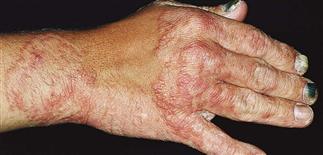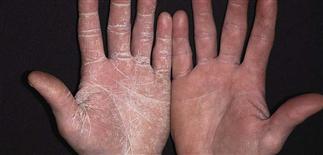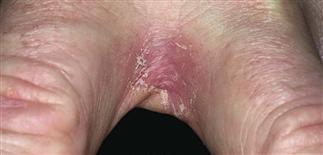78
Tinea of the hand

Sharply defined, scaling borders. Infected first, second, third nails. Misdiagnosed as eczema and treated with topical steroids. Nails and skin cleared with terbinafine 250 mg q.d. 6 weeks.

Topical steroids were prescribed and infection lost characteristic tinea features. Scaling border and surface scale disappeared. Plaque thickened and became painful. This is called tinea incognito.

Thick palmar scale often considered dry skin. Mildly itching infection similar to that on soles. One hand involved typical. Check feet for same pattern. Recurrence common even after oral medication.

Inflammation of webs occurs in those exposed to moisture. Eruption eczematous (intertrigo) or infected with dermatophyte fungi, Candida, bacteria. Econazole cream treats fungi, yeast, some bacteria.
DESCRIPTION
Tinea of the back of the hand has the same pattern of infection as is seen on the body. May look like eczema or psoriasis, especially if border indistinct. Tinea of the palm is often misinterpreted by the patient as just dry skin.
HISTORY
• Rarely seen in children. • Slowly progressive and minimally symptomatic. • Often misdiagnosed as eczema and treated inappropriately with topical steroids. • Typical ringworm pattern of infection on the back of the hand responds to treatment sooner than the dry, thick palms.
PHYSICAL FINDINGS
• Tinea involving the back of the hand has all the features of classic ringworm lesions on the body. A raised, red, scaly, advancing border is typical. Papules or vesicles may be present at the border or in the central area. • Tinea involving the palm has the same appearance as the dry, diffuse, keratotic form of tinea on the soles. Patients with palm infections frequently have infected soles. The usual pattern of infection is involvement of one hand and two feet or of two hands and one foot. • Hyperkeratotic tinea of the palms may be asymptomatic; the patient may be unaware of the infection, attributing the dry, thick, scaly surface to hard physical labor. • Diagnosis is subtle and easily missed. The thickened palms may be severely dry and develop cracks and fissures. Fingernail fungal infection (onychomycosis) may accompany tinea manuum. A potassium hydroxide wet mount or fungal cultures prove the diagnosis.
TREATMENT
• Infection of the dorsum and palms may respond to topical antifungal creams such as terbinafine (Lamisil) or butenafine hydrochloride (Lotrimin Ultra), but oral medication is more reliable. Terbinafine (Lamisil) 250 mg q.d. for 2 or 4 weeks, itraconazole (Sporanox) 200 mg q.d. or 200 mg b.i.d. for 1–2 weeks, or Diflucan 150 mg once weekly for 2 or 4 weeks is effective. Ultramicrosize griseofulvin 250 mg or 330 mg b.i.d. for 3–6 weeks also effective. • Treatment of nail infections requires a 6-week course of terbinafine or pulse dosing with itraconazole (200 mg b.i.d., 1 week on, 3 weeks off, for 2–3 months). • Reevaluate patients with palm infections in 6 months; there is a significant recurrence rate.







